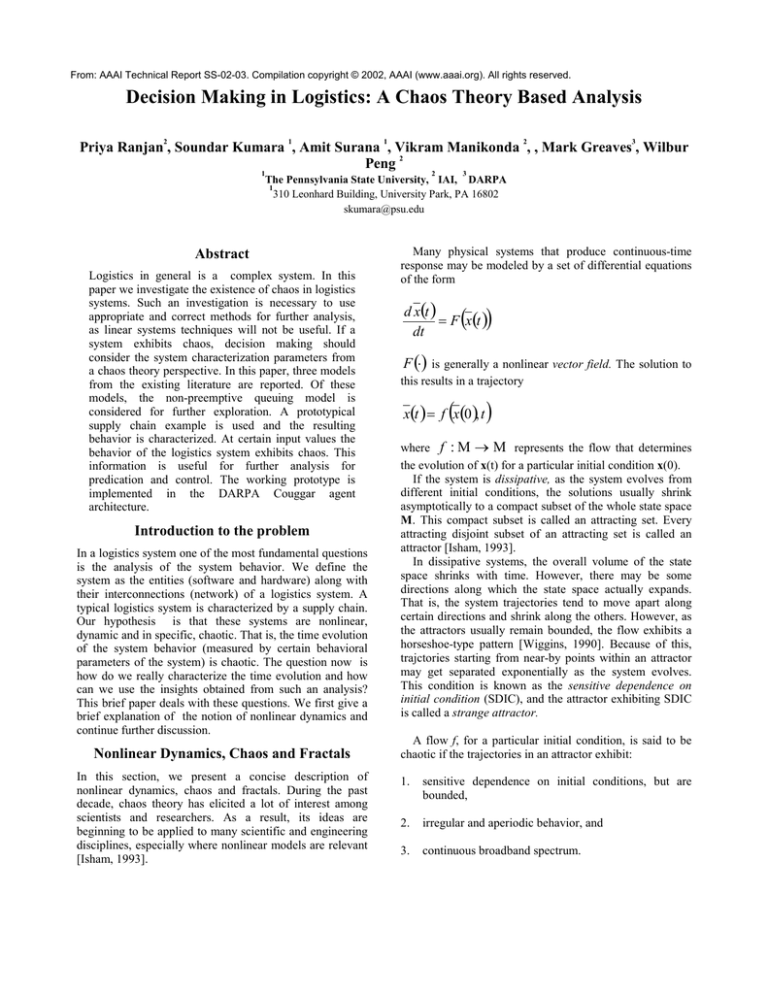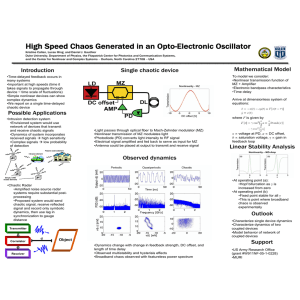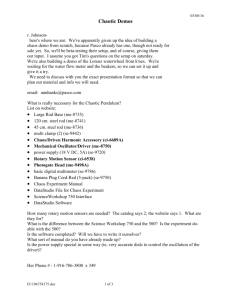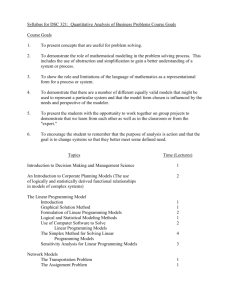
From: AAAI Technical Report SS-02-03. Compilation copyright © 2002, AAAI (www.aaai.org). All rights reserved.
Decision Making in Logistics: A Chaos Theory Based Analysis
Priya Ranjan2, Soundar Kumara 1, Amit Surana 1, Vikram Manikonda 2, , Mark Greaves3, Wilbur
2
Peng
1
2
3
The Pennsylvania State University, IAI, DARPA
1
310 Leonhard Building, University Park, PA 16802
skumara@psu.edu
Abstract
Logistics in general is a complex system. In this
paper we investigate the existence of chaos in logistics
systems. Such an investigation is necessary to use
appropriate and correct methods for further analysis,
as linear systems techniques will not be useful. If a
system exhibits chaos, decision making should
consider the system characterization parameters from
a chaos theory perspective. In this paper, three models
from the existing literature are reported. Of these
models, the non-preemptive queuing model is
considered for further exploration. A prototypical
supply chain example is used and the resulting
behavior is characterized. At certain input values the
behavior of the logistics system exhibits chaos. This
information is useful for further analysis for
predication and control. The working prototype is
implemented in the DARPA Couggar agent
architecture.
Introduction to the problem
In a logistics system one of the most fundamental questions
is the analysis of the system behavior. We define the
system as the entities (software and hardware) along with
their interconnections (network) of a logistics system. A
typical logistics system is characterized by a supply chain.
Our hypothesis is that these systems are nonlinear,
dynamic and in specific, chaotic. That is, the time evolution
of the system behavior (measured by certain behavioral
parameters of the system) is chaotic. The question now is
how do we really characterize the time evolution and how
can we use the insights obtained from such an analysis?
This brief paper deals with these questions. We first give a
brief explanation of the notion of nonlinear dynamics and
continue further discussion.
Nonlinear Dynamics, Chaos and Fractals
In this section, we present a concise description of
nonlinear dynamics, chaos and fractals. During the past
decade, chaos theory has elicited a lot of interest among
scientists and researchers. As a result, its ideas are
beginning to be applied to many scientific and engineering
disciplines, especially where nonlinear models are relevant
[Isham, 1993].
Many physical systems that produce continuous-time
response may be modeled by a set of differential equations
of the form
d x(t )
= F x(t )
dt
( )
⋅ is generally a nonlinear vector field. The solution to
F ()
this results in a trajectory
(
x(t ) = f x(0 ), t
)
where f : M → M represents the flow that determines
the evolution of x(t) for a particular initial condition x(0).
If the system is dissipative, as the system evolves from
different initial conditions, the solutions usually shrink
asymptotically to a compact subset of the whole state space
M. This compact subset is called an attracting set. Every
attracting disjoint subset of an attracting set is called an
attractor [Isham, 1993].
In dissipative systems, the overall volume of the state
space shrinks with time. However, there may be some
directions along which the state space actually expands.
That is, the system trajectories tend to move apart along
certain directions and shrink along the others. However, as
the attractors usually remain bounded, the flow exhibits a
horseshoe-type pattern [Wiggins, 1990]. Because of this,
trajctories starting from near-by points within an attractor
may get separated exponentially as the system evolves.
This condition is known as the sensitive dependence on
initial condition (SDIC), and the attractor exhibiting SDIC
is called a strange attractor.
A flow f, for a particular initial condition, is said to be
chaotic if the trajectories in an attractor exhibit:
1.
sensitive dependence on initial conditions, but are
bounded,
2.
irregular and aperiodic behavior, and
3.
continuous broadband spectrum.
The irregular and aperiodic response of chaotic systems,
usually betrays a special property of self-similarity or scale
invariance. That is, the response appears similar over
multiple scales of observation. Scale invariant
mathematical entities are commonly known as fractals.
Analytical techniques used to deduce the characteristics of
nonlinear systems collectively constitute fractal analysis.
The main objectives of fractal analysis can be broadly
categorized depending on the end-purpose as follows:
arise in different models that represent some of components
in a supply chain. In the following sections we reproduce
three models which are fundamental in understanding and
explaining chaos in supply chain ( Frameworks that can be
used for modeling supply chains). For the sake of clarity we
are reproducing these models here. Details can be found in
the relevant references cited.
1.
identification of the presence of chaos from the system
response;
2.
establishing the invariants of the system dynamics-for
system identification or indirect state estimation; and
3.
chaos modeling-when the end-purpose is to capture
and later reproduce the system dynamics.
A managerial system, allocates resources to its production
and marketing departments in accordance with shifts in
inventory and/or backlog [Rasmussen, and Moseklide,
1988] It has four level variables: resources in production,
resources in sales, inventory of finished products and
number of customers. In order to represent the time
required to adjust production, a third order delay is
introduced between production rate and inventory. The sum
of the two resource variables is kept constant. The rate of
production is determined from resources in production
through a nonlinear function, which expresses a decreasing
productivity of additional resources as production
approaches maximum capacity. The sales rate, on the other
hand, is determined by the number of customers and by the
average sales per customer-year. Customers are mainly
recruited through visits of the company salesman. The rate
of recruitment depends upon the resources allocated to
marketing and sales, and again it is assumed that there is a
diminishing return to increasing sales activity: Once
recruited, customers are assumed to remaining with the
company for an average period AT, the association time.
A difference between production and sales causes the
inventory to change. The Company is assumed to respond
to such changes by adjusting its resource allocation. When
the inventory is lower than desired, on the other hand,
resources are redirected from sales to production. A certain
minimum of resources is always maintained in both
production and sales. In the model, this is secured by means
of two limiting factors, which reduce the transfer rate when
a resource lower-bound is approached. Finally the model
assumes that there is a feedback from inventory to
customer defection rate. If the inventory of finished
products becomes very low, the delivery time is assumed to
become unacceptable to many customers. As a
consequence, the defection rate is enhanced by a factor
1+H. We summarize the dynamical behavior of the system
in the following.
A more detailed description of these concepts may be
found in [Bukkapatnam et al., 2000]. In the rest of this
paper we report three different models existing in literature
[these are not our original models] that are useful in supply
chain analysis. We consider the queuing model and apply it
to the logistics scenario in the Cougaar architecture and
discuss the results. We raise the fundamental question of
how we can use these results for further analysis and
control of a logistics system.
Supply chain and nonlinearity
The notion of evolution over time falls into the realm of
what physicists call dynamics. Logistics systems are
dynamic. Their behavior can be nonlinear. Therefore we
can model a logistics system using the principles of
nonlinear dynamics. A supply chain is an example of a
logistics system. A typical supply chain exhibits stable
behavior with damped oscillations in response to external
disturbances. Unstable phenomena however can arise, due
to feedback structure, inherent adjustment delays and
nonlinear decision-making processes that go in a supply
chain. One of the causes of unstable phenomena is that the
information feedback in the system is slow relative to rate
of changes that occur in the system. Nonlinearity is
inherent in a supply chain. The first mode of unstable
behavior to arise in nonlinear systems is usually the simple
one-cycle self-sustained oscillations. If the instability
drives the system further into the nonlinear regime, more
complicated temporal behavior may be generated. The
route to chaos through subsequent period-doubling
bifurcations, as certain parameters of the system are varied,
is generic to large class of systems in physics, chemistry,
biology, economics and other fields. Functioning in chaotic
regime deprives the ability for long-term predictions about
the behavior of the system, while short-term predictions
may be possible sometimes. As a result, control and
stabilization of such a system becomes almost impossible.
Here we investigate such dynamical behaviors that can
Managerial System
Dynamical Behavior
The managerial system described by the authors
[Rasmussen, and Moseklide, 1988] is controlled by two
interacting negative feedbacks. Combined with the delays
involved in adjusting production and sales, these loops
create the potential for oscillatory behavior. If the transfer
of resources is fast enough, this behavior is destabilized and
the system starts to perform self-sustained oscillations. The
amplitude of these oscillations is finally limited by the
various nonlinear restrictions in the model, particularly by
the reduction of resource transfer rate as lower limits to
resources in production or resources in sales are
approached.
A series of abrupt changes in the system behavior is
observed as competition between the basic growth tendency
and nonlinear limiting factors is shifted. The simple onecycle attractor corresponding to H=10, becomes unstable
for H=13 and a new stable attractor with twice the original
period arises. If H is increased to 28 the stable attractor
attains a period of 4. As H is further increased, the perioddoubling bifurcations continue until H=30 the threshold to
chaos is exceeded. The system now starts to behave in an
aperiodic and apparently random behavior. Hence the
system shows chaotic behavior through a series of period
doubling bifurcations.
Deterministic Queuing Model
Consider a simple discrete-time deterministic queuing
model, with one server and two queuing lines (X and Y)
representing some activity [Feichtinger, et al.,1994]. The
input rates of both queues are constant and their sum equals
the server-capacity. In each time period the server has to
decide how much time to spend on each of the two
activities. Let:
α : Constant input rate for activity X
β : Constant input rate for activity Y
Φ X : Time spent on activity X
Φ Y : Time spent on activity Y
xk : Queue length of X
y k : Queue length of Y
The amount of time Φ X and Φ Y that will be spent on
activities X and Y in period k+1 are determined by an
adaptive feedback rule depending on the difference of the
queue lengths xk and y k . The decision rule or policy
function says that longer queues are served with higher
priority. Two possibilities considered are:
•All-or nothing decision: the server decides to spend all its
time on the activity corresponding to the longer queue.
Hence Φ is a Heaviside function given by
Φ( x − y ) = 1 if x ≥ y
= 0 if x < y
•Mixed Solutions: the server decides to spend most of its
time to the activity corresponding to the longer queue. For
this decision function a S-shaped logistic function is used
as given by
Φ( x − y ) =
1
1 + e k ( x− y )
The parameter k tunes the “steepness” of the S-shape.
With these decision functions the new queue lengths
xk +1 and y k +1 are given equations
xk +1 = xk + α − Φ( xk − y k )
y k +1 = y k + β − Φ ( xk − y k )
Using the constraints α + β = 1 and Φ X + Φ Y = 1 , it is
sufficient to consider the dynamics of the map in order to
study the behavior of the system
f ( x ) = x + α − Φ ( 2 x − 2)
We summarize the dynamical behavior discussed in
[Feichtinger, et al.,1994] in the following.
Dynamical Behavior
For 0<k<4 and for all 0< α <1, the map f has a globally
stable equilibrium. Simulation shows that when the
parameter k is not too large the bifurcation diagrams with
respect to α are simple. For larger values of k (e.g k=7.3)
chaotic behavior arises after infinitely many period
doubling bifurcations, as α is increased from 0.0 to 0.3.
However, when α is further increased from 0.3 to 0.5,
chaos disappears, after many period halving bifurcations.
For 0.5< α <1 the bifurcations scenario is qualitatively the
same as for 0< α <0.5 since the system is symmetric w.r.t
α =0.5 and x=1. Physically, when α is close to 0, there
is stable equilibrium, meaning that in the long run, in each
time period the server spends a fixed proportion of time to
each of the two activities, and it spends most of the time to
the activity Y with the highest input rate. For α close to 1
we have same behavior, with the activities X and Y
interchanged. For α close to 0.5, i.e. when the input rates
of the two activities are almost equal, the equilibrium is
unstable, and there is stable period 2 orbit. This means that
in one period most of the time is spent on activity X, then
in next period most of time is spent on activity Y, and again
on activity X and so on. Chaotic behavior arises when α is
somewhere between 0 and 0.5 or between 0.5 and 1, for
α =1/3 and α =2/3 . Hence, a steep decision function
together with a situation where the input rate of one activity
is around twice the input rate of the other activity leads to
irregular queue lengths.
As k → ∞ , the decision function Φ converges to the
Heaviside function. The dynamical behavior of the queuing
model in that case is equivalent to rigid rotation on a circle.
For rational α = p / q of input rate, every point x is
periodic with period q. In that case, of every q time periods
p time periods are completely spent on the first activity,
while the remaining q-p time periods are spend on the other
activity. On the other hand when α is irrational the
dynamical behavior is quasi-periodic and every point x is
aperiodic.
Preemptive Queuing Model with Delays
The
Queuing
system
[Erramilli,
and
Forys,
1991]considered here has two queues (A and B) and a
single server with following characteristics:
• Once served, the class A customer returns as a class B
customer after a constant interval of time
• Class B has non-preemptive priority over class A, i.e.,
the class A queue does not get served until the class B
queue is emptied.
• Schedules are organized every T units of time, i.e., if the
low priority queue is emptied within time T, the server
remains idle for the remaining time interval.
• Finally, the higher priority class B has a lower service
rate than the low priority class A
Suppose the system is sampled at the end of every
schedule cycle, and the following quantities are observed at
the beginning of the kth interval:
Ak : Queue length of low priority queue
Bk : Queue length of high priority queue
C k : Outflow from low priority queue in the kth interval
Dk : Outflow from high priority queue in the kth interval
λk : Arrival rate in the kth interval
The system is characterized by the following parameters:
µ a : Service rate for the lower priority queue
µ b : Service rate for the higher priority queue
l: The feedback interval in units of the schedule cycle
The following four equations then completely describe
the evolution of the system:
(1)
Ak +1 = Ak + λ k − C k
C k = min( Ak + λk , µ a (1 −
Dk
))
µb
Figure 1: Non-preemptive Queuing Model
Dynamical Behavior
The analytic approach to solve for the flow model under
constant arrivals (i.e. λk = λ for all k) shows several
classes of solutions. The system is found to batch its
workload even for such perfectly smooth arrival patterns.
Following are the characteristics of behavior of the system:
• Above a threshold arrival rate ( λ ≥ µ b / 2 ), a
momentary overload can send the system into a number of
stable modes of oscillations.
• Each mode of oscillations is characterized by distinct
average queuing delays.
• Extreme sensitivity to parameters, and the existence of
chaos, implies the system at a given time may be any one
of a number of distinct steady-state modes.
The batching of the workload can cause significant
queuing delays even at moderate occupancies. Also such
oscillatory behavior significantly lowers the real-time
capacity of the system.
Of the three models discussed the model reported by
Erramalli and Forys (1991) is more realistic and can be
generalized. In the next section we explain our rationale for
selecting this model for adaptation to the logistics domain
and discuss the results.
(2)
Application of queuing model to logistics
scenario
Bk +1 = Bk + C k −l − Dk
(3)
Dk = min( Bk + C k −l , µ b )
(4)
Equations (1) and (3) are merely conservation rules, while
equations (2) and (4) model the constraints on the outflows
and the interaction between the queues. This model while
conceptually simple, exhibits surprisingly complex
behaviors. The dynamical behavior reported in [Erramilli,
and Forys, 1991] is summarized in the following.
The assumptions in the model proposed by Erramalli and
Forys (1991) are generic in the sense that priorities are
widely observed in large systems due to economic and
administrative compulsions. Sometime they can also arise
from the physical facts when two different stages of
processing have certain temporal constraint. Priorities may
also arise due to the non-homogeneity of the system where
“knowledge” level of one agent is different from the other.
Varying service time again follows from physical
constraints on the task. For example in a simple logistics
scenario tasks like unpacking, shipping, logging and
dispatching may take different times. These times scales
can vary widely depending on the nature and physical
characteristics of the tasks.
The considerations regarding the generality of
assumptions and the clear one-to-one correspondence
between the physical logistics tasks and the model
parameters described in [Erramilli, and Forys, 1991] made
us apply the queuing model to a simple, yet, realistic
logistics scenario.
Example Logistics Scenario
The example scenario consists of two stages modeled by
the non-preemptive queuing formalism. We take a simple
battle front scenario (this can be any context of supply of
materials, not necessarily battle front). During the first
stage, supplies are processed by the node (agent) This
involves two tasks:
Task A: Unpacking
Task B: Shipping
Our assumptions are as follows:
1. Shipping takes more resources than packing,
2. Shipping gets a non preemptive priority
3. Resources are common to both the tasks
The second stage consists of disbursement of supplies. The
output of first stage feeds into the second stage (as arrival).
The two associated tasks are:
Task A: Maintaining an inventory
Task B: Disbursing the supply to the troops
The assumptions at stage two are as follows:
1. Disbursing takes more resources than maintaining
inventory
2. Disbursing has a non pre-emptive priority
3. Resources are common to both the tasks
Figure 1 shows the queuing model. This is figure is
reproduced from [Erramilli, and Forys, 1991]. It must be
noted that that rules are very simple and generic. Priority
and heterogeneity are fundamental to any logistic planning
and scheduling. Tasks have to be prioritized in order to do
the most important thing first. This comes naturally as we
try to optimize a objective and assign the tasks their
“importance.” In addition in all logistics systems, resources
are limited, both in time and space. Temporal constraints
considered in the example are realistic, in the sense that
you can not disburse supplies without unpacking them.
Temporal dependence plays an important role in logistic
planning (interdependency). This simple example also
simulates the effect of arbitrary but bounded initial
conditions
Cougaar (Cognitive Agent Architecture) is developed
under DARPA Advanced Logistics Program (ALP).
Survivability of Cougaar is addressed in the UltraLog
program of DARPA. In the above example each stage is
modeled as an agent. The activities are modeled as agent
processes. We do not discuss Cougaar architecture in this
paper. Details can be found at the URL:
http://www.couggar.org.
Analysis
One of the hallmarks of chaos is sensitive dependency to
initial conditions (SDIC). External environment (the world
in which the logistics scenario resides) changes and hence
changing the initial conditions. The following affect the
initial conditions of the agents ( thereby affecting the initial
conditions of the queuing model):
1. Change in arrival rate of supplies (inputs to the
agents),
2. Change in resources (assets) available in each
agent, and
3. Delay in processing of Tasks
The internal states of the two agents are characterized by:
1. Supplies waiting to be unpacked
2. Supplies waiting to be Shipped
3. Supplies actually shipped
4. Supplies waiting to be inventoried
5. Supplies waiting to be disbursed to the troops.
6. Supplies actually Shipped
We have considered the above six variables and
observed their behavior. Characterization of these
behaviors leads to some interesting inferences.
We simulated the queuing models in each agent with the
following model parameters. There are 162 personnel in
each of the agents, who can be allocated to either task. We
assume that it takes 1 unit of time and one person to do task
A and one unit of time with 2 people to do task B. This
defines the capacity/arrival rate as 54 items / unit time.
Hence arrival rate can be 0-54 per unit time. We assume
that the initial conditions are given by: x10=131, x20=201,
x30=151 and x40=29
We have used Matlab for computations. We have
experimented with several arrival rates and delays. We
observe the state-space structure (time evolution) of the
following:
1. Arrival rates at all the queues
2. Time series of various parameters
3. Power-spectrum
At arrival rates of 40 the system has a period of 1, at
arrival rate of 50 a period 2, at 52 a period of 4 and at 53
the system shows a seemingly random behavior. This
shows relatively irregular behavior with several different
peaks in the power spectrum. The bifurcation diagram
shows that at the arrival rate of 53 the system is chaotic.
We show illustrative plots in figure 2. Time evolution (2a)
clearly shows the existence of many periods showing the
possible existence of chaotic behavior. In these graphs the
following notations are used:
X1: No of jobs waiting at queue A in agent 1 (waiting to
be shipped)(Stage 1)
X2: No. of Jobs waiting at queue B in agent 1 (waiting
to be unpacked))(Stage 1)
X3: No of jobs waiting at queue A in agent 2 (Waiting
to finish maintain inventory)(Stage 2)
X4: No of jobs waiting at queue B in agent 2 (waiting to
be disbursed) (Stage 2)
Evolution of system states
120
100
>2
X
d
n
a
1
X
et
at
S
80
60
40
20
70
65
60
55
50
85
80
75
Time->
90
95
100
(a): Time evolution of system state
(d) Multi-stability : Bifurcation diagram for the system
Figure 2: Plots for arrival rate =53
Power Spectrum of state X1
50
Discussion
40
30
)
B 20
d(
e
d
ut
i
n 10
g
a
M
m
ur
0
t
c
e
p
S
r
e
w -10
o
P
-20
-30
-40
0
0.1
0.2
0.4
0.3
0.5
Frequency
0.7
0.6
0.8
0.9
1
(b) Power spectrum
State space trajectories for center 2(blue) and for center 1(red)
150
100
>4
x,
2
x
50
0
0
100
50
x1,x3->
(c) State-space plot
150
We could successfully show with certain initial conditions
the existence of chaos in the simple yet realistic logistic
system. The underlying queuing model at arrival rates of 53
leads to the chaotic behavior of the number of jobs waiting
to be processed. The bifurcation diagram points to the fact
that Xj’s (for j=1,2,3,4) exhibit aperioidic behavior. The
physical implication is that the resources needed vary from
time to time and the logistics system will exhibit
nervousness, which is an undesirable property. We have
also observed a cascading effect (when one agent enters the
chaotic behavior, the connected agent also tends to exhibit
chaos). This leads to the problem of planning of later
stages facing much more uncertainty compared to the first
stage even for simple fixed deterministic arrivals. We have
also observed increased average delay. There is an increase
in delay by 25% if the system starts batching the load
From our analysis we can conclude that if the two agents
start load batching then inventory requirement may go to
200% as evident from the plots.
It is necessary to make sure in this case to keep the
arrival rates to less than 53, there by enforcing control
policies which will keep the system stable or quasi-stable.
If the system ends up being chaotic then we could perform
further analysis to study the characteristics and use them to
control the behavior in the short term. We also compute :
Average mutual information (ami), Global dimension
(g_dim), Local dimension (l_dim), Correlation dimension
(c_dim) and Largest Lyapunov Exponent (l_exp).These
computed values also indicate the existence of Chaos in
this logistics system.
Chaotic behavior in deterministic dynamical systems is
an intrinsically non-linear phenomenon. We could
successfully show that a simple example logistics system is
chaotic. A characteristic feature of a chaotic systems is an
extreme sensitivity to changes in initial conditions while
the dynamics, at least for the so-called dissipative systems,
is still constrained to a finite region of the state space called
an attractor. In such instances, Fourier analysis and ARMA
models may not be useful to study the time traces of supply
chain systems. The need to extract interesting physical
information about the dynamics of observed systems when
they are operating in a chaotic regime has led to
development of nonlinear time series analysis techniques.
Systematically, the study of potentially, chaotic systems
may be divided into three areas: identification of chaotic
behavior, modeling and prediction and control. The first
area shows how chaotic systems may be separated form
stochastic ones and, at the same time, provides estimates of
the degrees of freedom and the complexity of the
underlying chaotic system. Based on such results,
identification of a state space representation allowing for
subsequent predictions may be carried out. The last stage,
if desirable, involves control of a chaotic system. In this
short paper we have concentrated on the first area i.e.
identification of chaotic behavior. In general if we consider
this step in spatio-temporal regime, the following tasks are
needed to be accomplished[Abarbanel, 1996]:
• Signal Separation (Finding the signal):
Separation of broadband signal form broadband
“noise” using deterministic nature of signal.
• Phase Space reconstruction (Finding the space):
Time lagged variables are used to form
coordinates for a phase space in dE dimension:
y (n) = [ x(n), x(n + T ),......x(n + (d E − 1)T )]
•
•
dE is determined using false nearest neighbors test
and time lag T using mutual information.
Classification of the signal: Determination of
invariants of system such as Lyapunov exponents,
various fractal dimensions.
Making models and Prediction: Determination of
the parameters a j of the assumed model
y (n) → y (n + 1)
y (n + 1) = F ( y (n), a1 , a 2 ,.....a p )
which are consistent with invariant classifiers
(Lyapunov exponents, dimensions).
In this paper we have discussed three models which can
represent the components of a supply chain. The nonpreemptive queuing model is used for detailed application
to a part of a supply chain, two agents interacting in a
military logistics scenario. The queuing model forms the
processing component of the logistics agents implemented
in the Cougaar architecture. One of the manifestations of
complexity is through the onset of chaos. Our analysis
shows the cascading effect of chaos. This points to the
conjecture that the supply chain may exhibit chaotic
behavior. The underlying motivation of our study is to
build control models. Our next step in this research is to
build adaptive predictive and control models for larger
networks from the insights we have derived from the
current analysis.
Acknowledgement
Soundar Kumara wishes to acknowledge DARPA for its
support (Grant#: MDA 972-01-1-0563) under the UltraLog
program for this research.
Author Affiliations
Soundar Kumara,(Corresponding author) Amit Surana:
Department of Industrial and Manufactuinrg Engineering,
310 Leonhard Building, The Pennsylvania State University,
University Park, PA 16802
Priya Ranjan, Vikram Manikonda, Wilbur Peng: Intelligent
Automation Inc., 7519 Standish Place, Suite 200,
Rockville, MD 20855.
Mark Greaves, DARPA TTO/JLTO, 3701 N. Fairfax
Drive, Arlington, VA 22203
References
Abarbanel, H.D.I. Analysis of Observed Chaotic Data.
Springer-Verlag New York Inc. 1996.
Bukkapatnam, S.T.S., Kumara, S., and Lakhtakia, A.
2000. Fractal estimation of flank wear in turning ASME
Journal of Dynamic Systems, Measurements and Control..
122:89-94.
Erramilli, A. and Forys, L. J. Feb 1991. Oscillations and
Chaos in a Flow Model of a Switching System. IEEE
Journal on Selected Areas in Communications Vol.9, No
2:171-178.
Feichtinger, G., Hommes, C. H. and Herold W. 1994.
Chaos in a simple Deterministic Queuing System. ZORMathematical Methods of Operations Research 40:109119.
Isham, V 1993. Statistical Aspects of chaos: A review. In
Networks and Chaos - Statistical and Probabilistic Aspects,
Barndorff-Nielsen et al. (editors).
Rasmussen, R. D. and Moseklide, E. 1988. Bifurcations
and chaos in generic management model. European
Journal of Operations Research Science 35:80-88.
Wiggins, S. 1990. Introduction to Applied Nonlinear
Dynamical Systems and Chaos. Springer-Verlag New
York, Inc.







